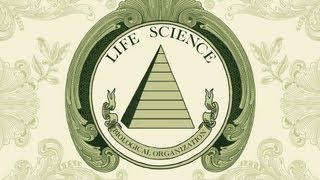(单词翻译:单击)
I like to think of life science as one big pyramid.
我喜欢把生命科学看做一个巨大的金字塔。
Let's call the pyramid, "biological organization".
我们将这个金字塔叫做“生命系统”。
Let's work our way from very small and specific concepts to very large and complex topics.
我们一起从微小具体的概念延伸到复杂的大话题。
So let's start at the tip of the pyramid,
让我们从金字塔的顶端开始吧,
with something so small, it can't be seen by the human eye, a single cell.
一个细胞,那么小的东西,人的肉眼是无法看到的。
A cell by itself is the most basic component of life.
细胞本身是生物最基础的单位。
A single cell, which is capable of living on its own,
一个能够独自生存的细胞
is called a unicellular organism, organisms like bacteria or protists.
被称为一个单细胞生物,比如细菌和原生生物。
These organisms are everywhere you look, you just can't see them.
这些生物到处都是,你只是看不见而已。
But, when cells join together, with more than one cell like itself to perform a similar function, it's no longer a unicellular organism.
但是当细胞结合在一起时,有很多同样的细胞,拥有同样的功能,它就不再是一个单细胞生物了。
It's then called a tissue. No, not that kind of tissue.
这时它就叫一个细胞组织。不,不是餐巾纸。
There are four types of tissues found in the human body: connective, muscle, nervous, and epithelial.
在人体中有四种细胞组织:结缔组织、肌肉组织、神经组织和上皮组织。
Bone tissue is a type of connective tissue and it's not flimsy like a Kleenex at all.
骨组织是一种结缔组织,而且它不像舒洁面巾纸那么薄。
Blood is also an example of the same cells working together to perform the same job,
血液也是相同的细胞在一起完成相同的功能的一个例子,
but it's a liquid, again, not like a Kleenex at all.
但是它是液体,同样的,一点也不像舒洁面巾纸。
No matter what the consistency is, a tissue is a group of the same cells, working together to perform a similar function.
不管它的浓度是多少,一个组织就是指一组相同的细胞,一起合作完成一个类似的功能。
Any time there are different tissues working together, we then call it an organ.
当不同的细胞组织一起运作时,我们把它叫做一个器官。
That's the next level of the pyramid.
这是金字塔的下一层。
Animals aren't the only ones with organs; plants have organs too.
动物并不是唯一拥有器官的生物;植物同样也有器官。
When we find multiple different organs working together to perform the same job, we then call it an organ system.
当多种器官一起运作时,我们把它称作一个器官系统。
Take the digestive system, for example.
我们就以消化系统为例。
It's made up of a mouth, esophagus, stomach, pancreas, liver, gall bladder, small intestine, and large intestine, also known as your colon.
它的组成部分有:嘴巴,食道,胃,胰腺,肝,胆,小肠和大肠--也被称作结肠。

Although each individual organ in this organ system does a very different job,
尽管系统中的每一个器官都有不同的功能,
together, these organs work to achieve the one goal of taking all the nutrients out of the food we eat and getting rid of what we don't need.
但它们能一起完成一个目标:吸收我们吃的食物中的营养,并清除我们不需要的东西。
An organ system, by definition, can only do one job, like get the nutrients from our food,
一个器官系统,正如其定义,只能做一样事情,比如从食物中吸收营养,
send and receive electrical signals, or exchange oxygen for carbon dioxide.
发送并接受电子信号,或者将氧气换成二氧化碳。
Regardless of their individual function, all organ systems rely on one another to do the vital jobs which they can't do themselves.
不管它们有什么单独的功能,所有的器官系统都依靠彼此,去做无法独立完成的重要工作。
If one organ system doesn't work, the others will shut down, too.
如果一个器官系统不运行了,那么其它的也会停止运行。
An organism is a complicated, living thing, which requires the proper functioning of multiple organ systems to maintain stability.
一个生物是一个复杂的、富有生命的物体,需要多个器官系统的正常工作才能保持稳定。
This stability is called homeostasis.
这种稳定性叫做稳态。
When all organ systems are working together and maintaining homeostasis, then it results in a happy, living organism.
当所有的器官系统一起运作、保持稳态时,生物将是健康、快乐的。
Organisms are incredibly diverse and can be as simple as a bacteria or as complex as you.
生物体是非常多样的,可以简单到细菌,或者复杂得和你一样。
When a group of the same organisms, also known as a species, live together in the same environment, we then call it a population.
当一群同一种生物,也叫物种,生活在同样的环境中,我们把它叫做种群。
Often there are several populations all living in one environment. That is what we call a community.
通常有几个种群同时生活在一个环境中,这就是我们所说的群落。
Each time you look out the window, you're seeing a community.
每当你眺望窗外时,你能看见一个群落,
When we look at multiple communities, along with how all of the organisms interact with the physical environment, then we refer to it as an ecosystem.
当你看到多个群落,所有的生物都与自然环境互动时,我们把这个叫做生态系统。
When you look at all the ecosystems of Earth together, you're looking at the Earth.
当你看到所有的生态系统在一起时,你就是在看地球。
The Earth is a big, round circle of life.
地球是一个巨大的,生生不息的球体。
That's why we call it a biosphere - bio, meaning life and sphere, meaning circle. And there you go!
这就是为什么我们叫它一个生物圈--生物,代表生命,圈,代表圆形。就是这样!
When you break it down to each level, a very complex concept and phrase becomes easy to understand.
当你把它分解成一个个层次时,一个非常复杂的概念和术语变得十分易懂。
All life starts with a single cell. When cells join together, they are called a tissue.
所有的生命都从一个细胞开始。当细胞结合在一起,就变成了细胞组织。
A group of different tissues are called an organ, and a group of different organs are an organ system.
一群不同的细胞组织叫做器官,一组不同的器官叫做一个器官系统。
A group of organ systems working together make up an organism, and a group of the same organisms are a population.
一组器官系统在一起运行就是一个生物体,一群同样的生物体叫做一个种群。
Combining several different populations together give us a community.
将不同的种群结合起来,就形成了一个群落。
And several different communities in a large area is an ecosystem.
在一个大区域中几个不同的群落,这就是一个生态系统。
And every ecosystem together makes up our biosphere.
每一个生态系统在一起,组成了我们的生物圈。
And that, my friends, is biological organization, the pyramid of life.
这个,我的朋友们,就是生命系统,生命的金字塔。


